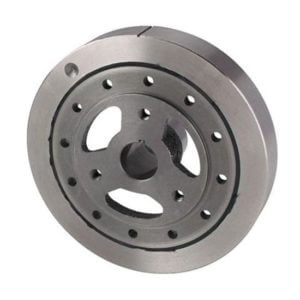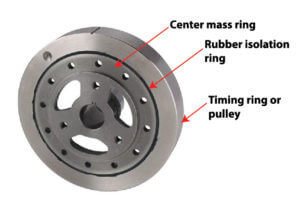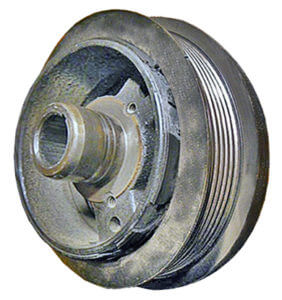What is a Harmonic balancer?

When engines need a harmonic work instead of just a pulley
A harmonic balancer looks much like an ordinary pulley but it’s not. It has several important additions. Harmonic balancers are also referred to a crankshaft damper, vibration damper and a crank pulley damper. Why would  a pulley need to dampen anything, and what’s the deal with using the word “harmonic” in reference to a pulley? To understand what a harmonic balancer does, you find have to understand how an internal combustion engine works.
a pulley need to dampen anything, and what’s the deal with using the word “harmonic” in reference to a pulley? To understand what a harmonic balancer does, you find have to understand how an internal combustion engine works.
Engines don’t produce even power; it comes in pulses
Most people think the engine rotates smoothly. It doesn’t. It rotates in jerks and pulses. Each time a piston fires, the piston connecting rod applies rotational force to the crankshaft. At the same time the crankshaft is in the process of pushing another piston up on a compression or exhaust stroke. So there’s tremendous counteracting forces being applied to the crankshaft. The crankshaft is designed to bend slightly to accommodate the counteracting forces to prevent breakage. In fact, the power stroke on a cylinder can cause the crankshaft to twist by as much as 2°. So what you see at the front of the engine is a series of pulsed rotations due to each power stroke and crankshaft twist. Between each power pulse, the crankshaft twist tends to spring back, so there’s really a forward and backwards twist.
The twisting and pulsing is why you need a damper
If you were to mount a solid pulley on the front of the crankshaft, each power pulse and crankshaft twist would transfer to the drive belt, causing them to vibrate from the stretch/release cycles of the engine. The end result would be a vibration or harmonic noise similar to plucking a guitar string. So the role of the vibration dampener/harmonic balancer is to isolate the pulses and prevent the belt and driven components from vibrating.
Balancer construction
The balancer can be constructed in two ways: with a rubber isolation ring or with a fluid isolation system. Most car makers choose the rubber isolation ring style because it’s  much cheaper than the fluid isolation style and it does the job. A rubber isolation harmonic balancer has three components; a heavy cast or machined center portion designed to create mass, a rubber isolation ring and an outer pulley.
much cheaper than the fluid isolation style and it does the job. A rubber isolation harmonic balancer has three components; a heavy cast or machined center portion designed to create mass, a rubber isolation ring and an outer pulley.
Just like a flywheel in an engine, the center portion’s mass is designed to add smooth power flow through inertia. Spin a heavy weight and its inertia helps it continue spinning between power pulses. The center portion transfers that inertia to the rubber isolation ring which then transfer it to the pulley and drive belts. The complete assembly not only drives the belts, but also reduces belt vibration and noise.
A fluid isolation system is similar, but instead of using a rubber ring, it relies on a thick silicone fluid and grooved channels, similar to viscous clutches used in radiator fans and AWD center differentials.
How does a harmonic balancer fail?
Simple. The rubber isolation ring deteriorates and disintegrates. In a severe failure situation the rubber ring is completely destroyed and the pulley disengaged from the center portion
causing the drive belts to fall off.
The constant twist/untwist causes the rubber to heat. The balancer is designed to handle this normal heat generation. However, it’s not designed to handle extra heat caused by engine overheating, radiator fan failure, and reduced engine compartment airflow from clogged radiator fins. That extra heat can dramatically accelerate deterioration of the rubber isolation ring.
In addition to heat deterioration, fluid contamination can also accelerate decomposition of the rubber isolation ring. If you have an engine oil leak or coolant leak that flows onto the harmonic balancer, that fluid will degrade the rubber. The oil and coolant contamination first softens the rubber causing a change in vibration frequency that you can hear from under the hood, but usually not from the driver’s seat. A technician with a stethoscope can pick up the vibrations of a bad harmonic balancer. In some cases, you can also see the belt vibration, again, like plucking a guitar string. As the rubber deteriorates even more, you’ll notice engine vibration at higher RPMs.
What are the symptoms of a failing balancer?
Vibration noise associated with engine RPM is the early first symptom of failure. As the harmonic balancer deteriorates more, it may squeal or squeak, making you think you’ve got a bad belt. Many DIYers and shops replace the belt and tensioner without checking the condition of the harmonic balancer. After replacing those parts, the vibration may get better, but that’s only because the automatic belt tensioner is compensating for the belt vibration. However, if the harmonic balancer isn’t replaced, the automatic belt tensioner will fail prematurely.
In final failure mode, the outer pulley ring comes off, disengages the belts and causing significant engine damage (broken crankshaft) or under-hood damage (flying parts damage AC compressor, alternator, P.S. pump, etc).
Harmonic balancer replacement cost
The repair involves removing all the drive belts, using a harmonic balancer remover tool and replacing with a new unit. Here’s some examples of balancer replacement costs for several makes and models:
Balancer replacement cost 2010 Ford Taurus 3.5L engine: Labor 1.4 hours Ford part $75 Total price approx. $225
Balancer replacement cost 2003 Toyota Camry 3.0L engine: Labor .7-hrs Toyota part $345 Total price $415
Balancer replacement cost 2007 Chevrolet Malibu 3.5L engine: Labor .6-hrs. GM part $105 Total price $165
Balancer replacement cost 2011 Audi A4 Sedan 2.0L Turbo engine: Labor 2.6-hrs Audi part $250 Total price $510
For imformation on how to replace a harmonic balancer, see this post
©, 2017 Rick Muscoplat

